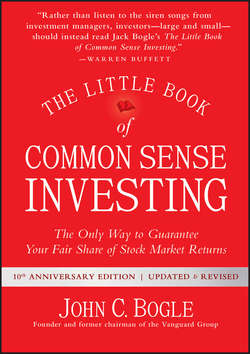The Little Book of Common Sense Investing

Реклама. ООО «ЛитРес», ИНН: 7719571260.
Оглавление
Bogle John C.. The Little Book of Common Sense Investing
Little Book Big Profits Series
Introduction to the 10th Anniversary Edition
Chapter One. A Parable
Chapter Two. Rational Exuberance
Chapter Three. Cast Your Lot with Business
Chapter Four. How Most Investors Turn a Winner’s Game into a Loser’s Game
Chapter Five. Focus on the Lowest- Cost Funds
Chapter Six. Dividends Are the Investor’s (Best?) Friend
Chapter Seven. The Grand Illusion
Chapter Eight. Taxes Are Costs, Too
Chapter Nine. When the Good Times No Longer Roll
Chapter Ten. Selecting Long-Term Winners
Chapter Eleven “Reversion to the Mean”
Chapter Twelve. Seeking Advice to Select Funds?
Chapter Thirteen. Profit from the Majesty of Simplicity and Parsimony
Chapter Fourteen. Bond Funds
Chapter Fifteen. The Exchange-Traded Fund (ETF)
Chapter Sixteen. Index Funds That Promise to Beat the Market
Chapter Seventeen. What Would Benjamin Graham Have Thought about Indexing?
Chapter Eighteen. Asset Allocation I: Stocks and Bonds
Chapter Nineteen. Asset Allocation II
Chapter Twenty. Investment Advice That Meets the Test of Time
Acknowledgments
WILEY END USER LICENSE AGREEMENT
Отрывок из книги
SUCCESSFUL INVESTING IS ALL about common sense. As Warren Buffett, the Oracle of Omaha, has said, it is simple, but it is not easy. Simple arithmetic suggests, and history confirms, that the winning strategy for investing in stocks is to own all of the nation’s publicly held businesses at very low cost. By doing so you are guaranteed to capture almost the entire return that these businesses generate in the form of dividends and earnings growth.
The best way to implement this strategy is indeed simple: Buy a fund that holds this all-market portfolio, and hold it forever. Such a fund is called an index fund. The index fund is simply a basket (portfolio) that holds many, many eggs (stocks) designed to mimic the overall performance of the U.S. stock market (or any financial market or market sector).1 The traditional index fund (TIF), by definition, basically represents the entire stock market basket, not just a few scattered eggs. It eliminates the risk of picking individual stocks, the risk of emphasizing certain market sectors, and the risk of manager selection. Only stock market risk remains. (That risk is quite large enough, thank you!) Index funds make up for their lack of short-term excitement by their truly exciting long-term productivity. The TIF is designed to be held for a lifetime.
.....
Yes, many individual companies fail. Firms with flawed ideas and rigid strategies and weak managements ultimately fall victim to the creative destruction that is the hallmark of competitive capitalism, only to be succeeded by other firms.3 But in the aggregate, businesses have grown with the long-term growth of our vibrant economy. Since 1929, for example, our nation’s gross domestic product (GDP) has grown at a nominal annual rate of 6.2 percent; annual pretax profits of our nation’s corporations have grown at a rate of 6.3 percent. The correlation between the growth of GDP and the growth of corporate profits is 0.98. (1.0 is perfect.) I assume that this long-term relationship will prevail in the years ahead.
This book intends to show you why you should stop contributing to the croupiers of the financial markets. Why? Because during the past decade they have raked in something like $565 billion each year from you and your fellow investors. It will also tell you how easy it is to avoid those croupiers: Simply buy a Standard & Poor’s 500 Index fund or a total stock market index fund. Then, once you have bought your stocks, get out of the casino – and stay out. Just hold the market portfolio forever. And that’s what the traditional index fund does.
.....